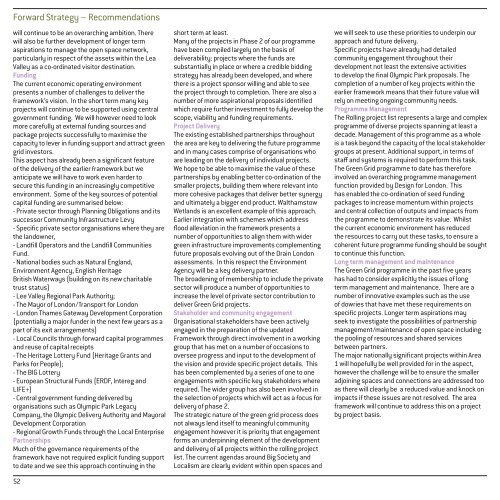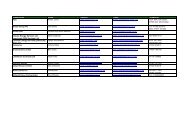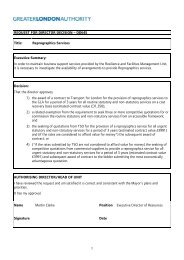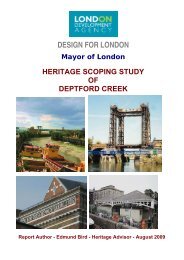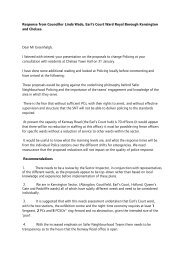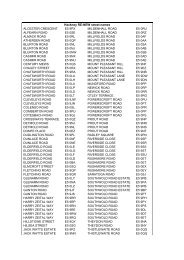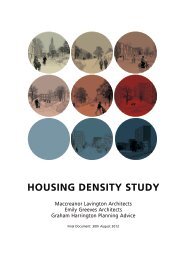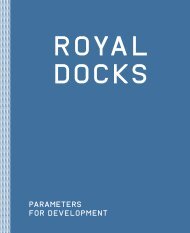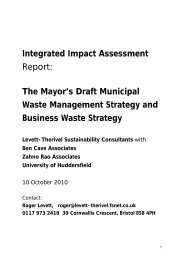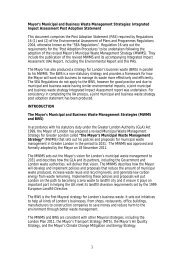AF01 Lee Valley and Finchley Ridge.pdf - Greater London Authority
AF01 Lee Valley and Finchley Ridge.pdf - Greater London Authority
AF01 Lee Valley and Finchley Ridge.pdf - Greater London Authority
You also want an ePaper? Increase the reach of your titles
YUMPU automatically turns print PDFs into web optimized ePapers that Google loves.
Forward Strategy – Recommendations<br />
will continue to be an overarching ambition. There<br />
will also be further development of longer term<br />
aspirations to manage the open space network,<br />
particularly in respect of the assets within the Lea<br />
<strong>Valley</strong> as a co-ordinated visitor destination.<br />
Funding<br />
The current economic operating environment<br />
presents a number of challenges to deliver the<br />
framework’s vision. In the short term many key<br />
projects will continue to be supported using central<br />
government funding. We will however need to look<br />
more carefully at external funding sources <strong>and</strong><br />
package projects successfully to maximise the<br />
capacity to lever in funding support <strong>and</strong> attract green<br />
grid investors.<br />
This aspect has already been a significant feature<br />
of the delivery of the earlier framework but we<br />
anticipate we will have to work even harder to<br />
secure this funding in an increasingly competitive<br />
environment. Some of the key sources of potential<br />
capital funding are summarised below:<br />
- Private sector through Planning Obligations <strong>and</strong> its<br />
successor Community Infrastructure Levy<br />
- Specific private sector organisations where they are<br />
the l<strong>and</strong>owner,<br />
- L<strong>and</strong>fill Operators <strong>and</strong> the L<strong>and</strong>fill Communities<br />
Fund.<br />
- National bodies such as Natural Engl<strong>and</strong>,<br />
Environment Agency, English Heritage<br />
British Waterways (building on its new charitable<br />
trust status)<br />
- <strong>Lee</strong> <strong>Valley</strong> Regional Park <strong>Authority</strong>;<br />
- The Mayor of <strong>London</strong>/Transport for <strong>London</strong><br />
- <strong>London</strong> Thames Gateway Development Corporation<br />
(potentially a major funder in the next few years as a<br />
part of its exit arrangements)<br />
- Local Councils through forward capital programmes<br />
<strong>and</strong> reuse of capital receipts<br />
- The Heritage Lottery Fund (Heritage Grants <strong>and</strong><br />
Parks for People);<br />
- The BIG Lottery<br />
- European Structural Funds (ERDF, Intereg <strong>and</strong><br />
LIFE+)<br />
- Central government funding delivered by<br />
organisations such as Olympic Park Legacy<br />
Company, the Olympic Delivery <strong>Authority</strong> <strong>and</strong> Mayoral<br />
Development Corporation<br />
- Regional Growth Funds through the Local Enterprise<br />
Partnerships<br />
Much of the governance requirements of the<br />
framework have not required explicit funding support<br />
to date <strong>and</strong> we see this approach continuing in the<br />
52<br />
short term at least.<br />
Many of the projects in Phase 2 of our programme<br />
have been compiled largely on the basis of<br />
deliverability: projects where the funds are<br />
substantially in place or where a credible bidding<br />
strategy has already been developed, <strong>and</strong> where<br />
there is a project sponsor willing <strong>and</strong> able to see<br />
the project through to completion. There are also a<br />
number of more aspirational proposals identified<br />
which require further investment to fully develop the<br />
scope, viability <strong>and</strong> funding requirements.<br />
Project Delivery<br />
The existing established partnerships throughout<br />
the area are key to delivering the future programme<br />
<strong>and</strong> in many cases comprise of organisations who<br />
are leading on the delivery of individual projects.<br />
We hope to be able to maximise the value of these<br />
partnerships by enabling better co-ordination of the<br />
smaller projects, building them where relevant into<br />
more cohesive packages that deliver better synergy<br />
<strong>and</strong> ultimately a bigger end product. Walthamstow<br />
Wetl<strong>and</strong>s is an excellent example of this approach.<br />
Earlier integration with schemes which address<br />
flood alleviation in the framework presents a<br />
number of opportunities to align them with wider<br />
green infrastructure improvements complementing<br />
future proposals evolving out of the Drain <strong>London</strong><br />
assessments. In this respect the Environment<br />
Agency will be a key delivery partner.<br />
The broadening of membership to include the private<br />
sector will produce a number of opportunities to<br />
increase the level of private sector contribution to<br />
deliver Green Grid projects.<br />
Stakeholder <strong>and</strong> community engagement<br />
Organisational stakeholders have been actively<br />
engaged in the preparation of the updated<br />
Framework through direct involvement in a working<br />
group that has met on a number of occasions to<br />
oversee progress <strong>and</strong> input to the development of<br />
the vision <strong>and</strong> provide specific project details. This<br />
has been complemented by a series of one to one<br />
engagements with specific key stakeholders where<br />
required. The wider group has also been involved in<br />
the selection of projects which will act as a focus for<br />
delivery of phase 2.<br />
The strategic nature of the green grid process does<br />
not always lend itself to meaningful community<br />
engagement however it is priority that engagement<br />
forms an underpinning element of the development<br />
<strong>and</strong> delivery of all projects within the rolling project<br />
list. The current agendas around Big Society <strong>and</strong><br />
Localism are clearly evident within open spaces <strong>and</strong><br />
we will seek to use these priorities to underpin our<br />
approach <strong>and</strong> future delivery.<br />
Specific projects have already had detailed<br />
community engagement throughout their<br />
development not least the extensive activities<br />
to develop the final Olympic Park proposals. The<br />
completion of a number of key projects within the<br />
earlier framework means that their future value will<br />
rely on meeting ongoing community needs.<br />
Programme Management<br />
The Rolling project list represents a large <strong>and</strong> complex<br />
programme of diverse projects spanning at least a<br />
decade. Management of this programme as a whole<br />
is a task beyond the capacity of the local stakeholder<br />
groups at present. Additional support, in terms of<br />
staff <strong>and</strong> systems is required to perform this task.<br />
The Green Grid programme to date has therefore<br />
involved an overarching programme management<br />
function provided by Design for <strong>London</strong>. This<br />
has enabled the co-ordination of seed funding<br />
packages to increase momentum within projects<br />
<strong>and</strong> central collection of outputs <strong>and</strong> impacts from<br />
the programme to demonstrate its value. Whilst<br />
the current economic environment has reduced<br />
the resources to carry out these tasks, to ensure a<br />
coherent future programme funding should be sought<br />
to continue this function.<br />
Long term management <strong>and</strong> maintenance<br />
The Green Grid programme in the past five years<br />
has had to consider explicitly the issues of long<br />
term management <strong>and</strong> maintenance. There are a<br />
number of innovative examples such as the use<br />
of dowries that have met these requirements on<br />
specific projects. Longer term aspirations may<br />
seek to investigate the possibilities of partnership<br />
management/maintenance of open space including<br />
the pooling of resources <strong>and</strong> shared services<br />
between partners.<br />
The major nationally significant projects within Area<br />
1 will hopefully be well provided for in the aspect,<br />
however the challenge will be to ensure the smaller<br />
adjoining spaces <strong>and</strong> connections are addressed too<br />
as there will clearly be a reduced value <strong>and</strong> knock on<br />
impacts if these issues are not resolved. The area<br />
framework will continue to address this on a project<br />
by project basis.


